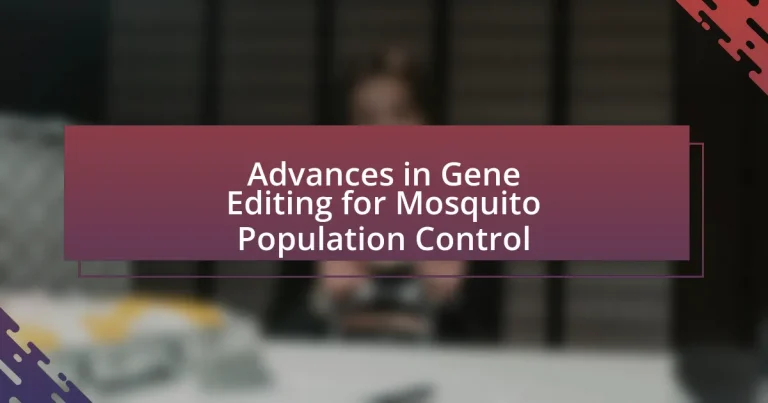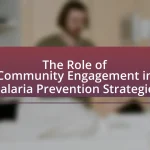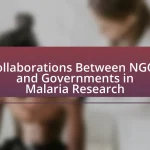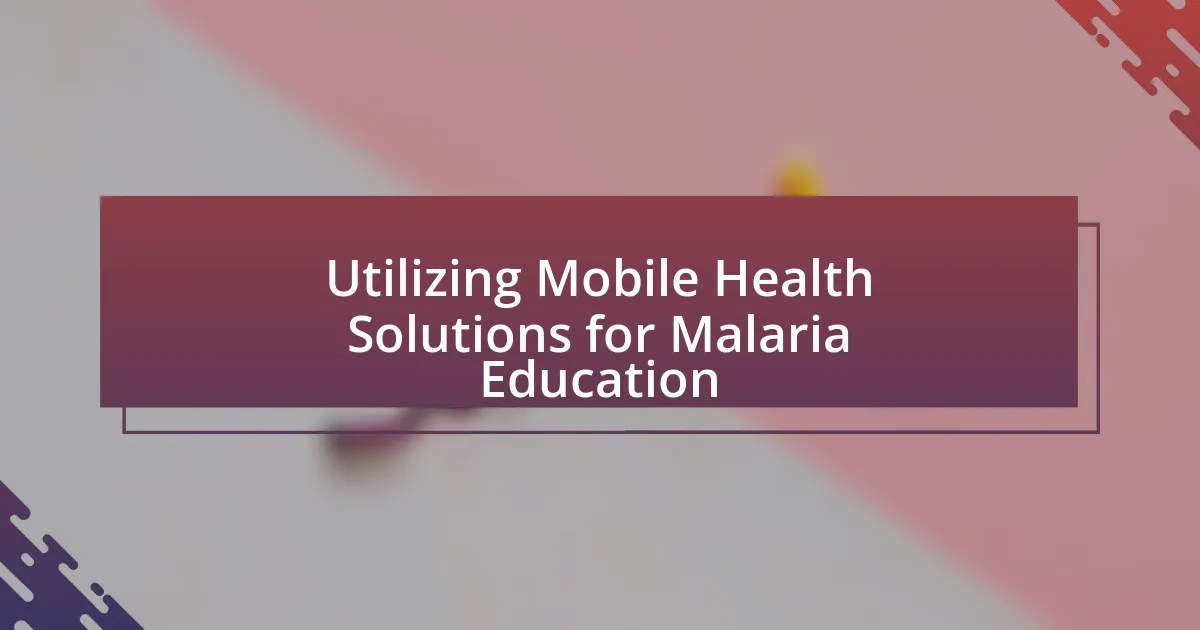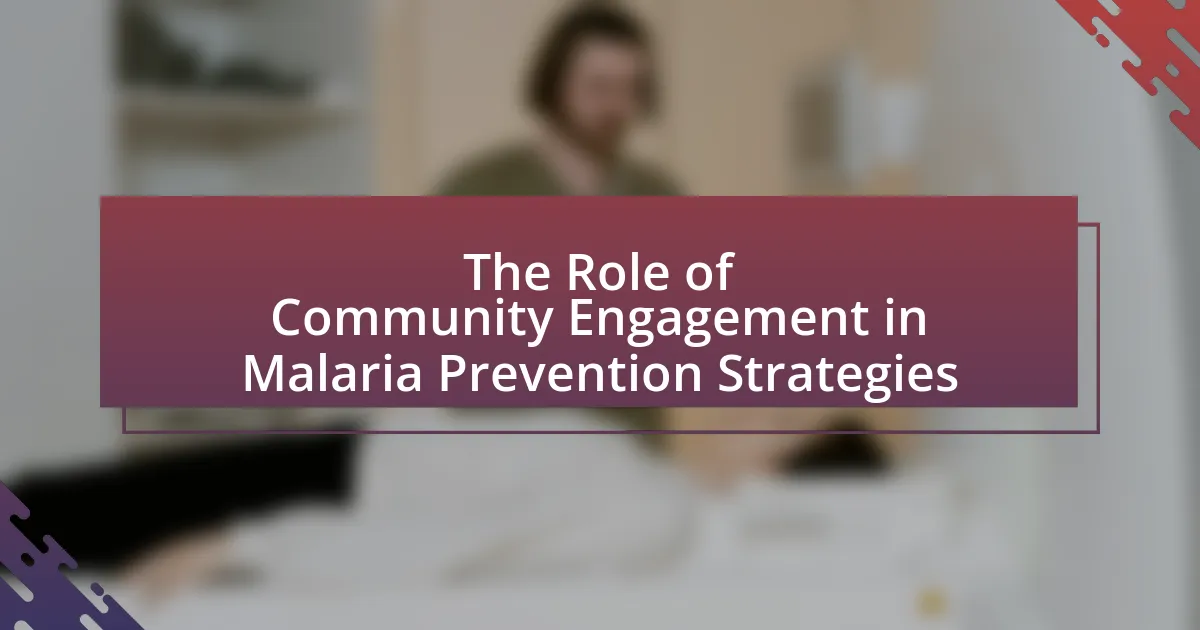The article focuses on recent advances in gene editing technologies, particularly CRISPR-Cas9, for controlling mosquito populations that transmit diseases such as dengue and malaria. It highlights the engineering of genetically modified mosquitoes, including the manipulation of specific genes like doublesex and Cas9, to suppress populations and reduce disease transmission. The implications of these technologies on public health, ecological balance, and ethical considerations are discussed, along with the regulatory frameworks governing their use. Additionally, the article explores future prospects and best practices for integrating gene editing with existing pest control methods to enhance effectiveness and safety.

What are the recent advances in gene editing for mosquito population control?
Recent advances in gene editing for mosquito population control include the development of CRISPR-Cas9 technology to create genetically modified mosquitoes that can reduce disease transmission. Researchers have successfully engineered Aedes aegypti mosquitoes to carry a gene drive that biases inheritance towards traits that suppress populations or render them incapable of transmitting pathogens like dengue and Zika viruses. For instance, a study published in Nature Biotechnology by Gantz et al. (2015) demonstrated the use of CRISPR to create a gene drive that could spread a lethal gene through mosquito populations, significantly decreasing their numbers. Additionally, ongoing field trials are assessing the effectiveness and ecological impact of these genetically modified mosquitoes, providing critical data for future applications in vector control.
How has CRISPR technology impacted mosquito gene editing?
CRISPR technology has significantly advanced mosquito gene editing by enabling precise modifications to their genomes, which can be used for population control. This technology allows researchers to target specific genes associated with traits such as fertility, disease resistance, and insecticide susceptibility. For instance, studies have demonstrated the successful use of CRISPR to create gene drives in mosquitoes, which can spread genetic modifications through populations rapidly. Research published in Nature Biotechnology by Gantz et al. (2015) showcased the potential of CRISPR-based gene drives to eliminate populations of disease-carrying mosquitoes, thereby reducing the transmission of malaria and dengue fever. This precision and efficiency in gene editing represent a transformative shift in strategies for managing mosquito populations and mitigating the spread of vector-borne diseases.
What specific gene targets are being modified in mosquitoes?
Specific gene targets being modified in mosquitoes include the doublesex gene, which influences sex determination, and the gene responsible for the production of the enzyme Cas9, used in CRISPR technology. Modifications to the doublesex gene can lead to the production of only male mosquitoes, thereby reducing the population over time, as males do not bite or transmit diseases. The use of Cas9 allows for precise editing of the mosquito genome, enabling researchers to introduce traits that can suppress populations or make them resistant to pathogens. These gene targets have been validated through studies demonstrating their effectiveness in controlling mosquito populations and reducing the spread of diseases such as malaria and dengue fever.
How does CRISPR-Cas9 work in the context of mosquito gene editing?
CRISPR-Cas9 works in mosquito gene editing by utilizing a guide RNA to direct the Cas9 enzyme to a specific DNA sequence, where it creates a double-strand break. This break triggers the cell’s repair mechanisms, which can be harnessed to introduce desired genetic changes, such as disrupting genes responsible for reproduction or disease transmission. Research has demonstrated that this method can effectively modify genes in species like Aedes aegypti, the primary vector for dengue and Zika viruses, leading to reduced populations or altered traits that hinder disease spread. For instance, a study published in Nature Biotechnology by Gantz et al. (2015) showcased the successful application of CRISPR-Cas9 to create gene drives in mosquitoes, promoting the inheritance of modified genes across generations.
What are the implications of gene editing on mosquito-borne diseases?
Gene editing has significant implications for mosquito-borne diseases by enabling the targeted reduction of mosquito populations that transmit pathogens. Techniques such as CRISPR-Cas9 allow scientists to modify genes in mosquito species, particularly Aedes aegypti, which is responsible for diseases like dengue and Zika. For instance, gene drives can be engineered to spread genetic modifications rapidly through populations, potentially leading to a collapse of disease-carrying mosquito numbers. Research published in Nature Biotechnology demonstrates that gene editing can effectively reduce the fertility of these mosquitoes, thereby decreasing their population and the incidence of associated diseases. This approach not only aims to control disease transmission but also raises ecological and ethical considerations regarding the long-term effects on ecosystems and biodiversity.
How can gene editing reduce the transmission of diseases like malaria and dengue?
Gene editing can reduce the transmission of diseases like malaria and dengue by altering the genetic makeup of mosquito populations to make them less capable of carrying and transmitting these pathogens. Techniques such as CRISPR-Cas9 allow scientists to introduce genes that either render mosquitoes resistant to the malaria parasite or reduce their lifespan, thereby decreasing the likelihood of them transmitting the disease. For instance, a study published in Nature in 2015 demonstrated that genetically modified Anopheles mosquitoes, which are responsible for malaria transmission, showed a significant reduction in the ability to transmit the Plasmodium parasite. This targeted approach not only aims to control mosquito populations but also directly impacts the transmission dynamics of these diseases, leading to potential reductions in infection rates among humans.
What are the potential ecological impacts of gene-edited mosquitoes?
Gene-edited mosquitoes can significantly alter ecosystems by disrupting existing food webs and species interactions. For instance, the release of gene-edited mosquitoes designed to reduce populations of disease-carrying species, such as Aedes aegypti, may lead to a decline in their predators, which rely on them as a food source. This could result in an imbalance in the ecosystem, affecting species diversity and population dynamics. Additionally, unintended consequences may arise if gene editing inadvertently affects other species or leads to the emergence of new pests. Research indicates that ecological impacts can be complex and unpredictable, as demonstrated by studies on genetically modified organisms in agriculture, where non-target species were affected.
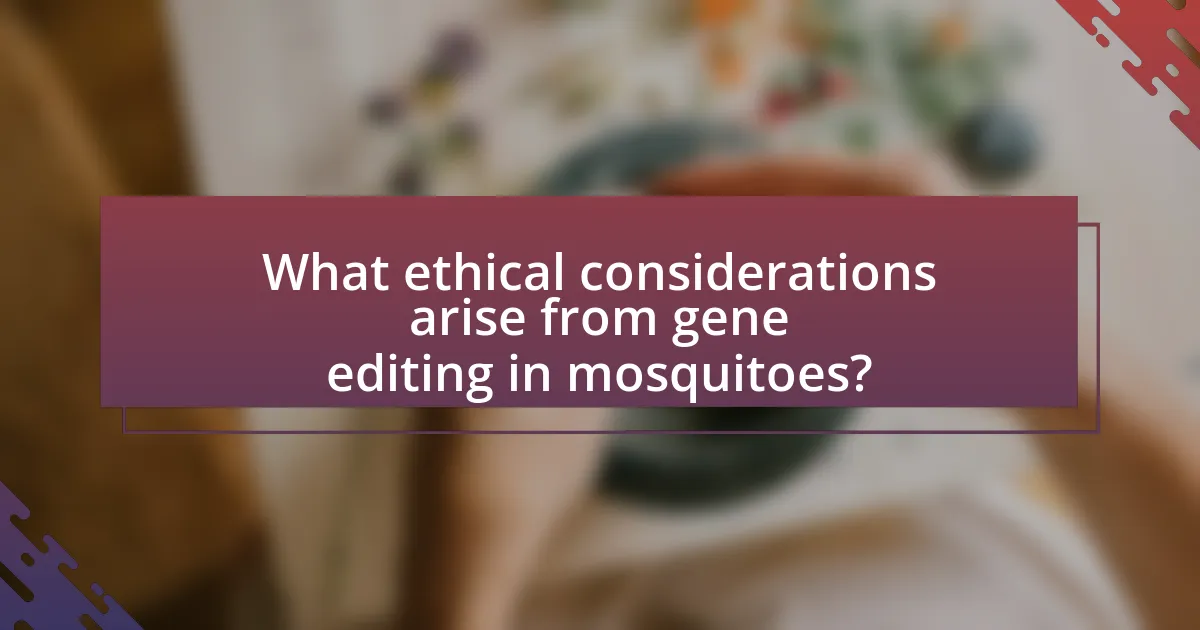
What ethical considerations arise from gene editing in mosquitoes?
Gene editing in mosquitoes raises significant ethical considerations, primarily concerning ecological balance, unintended consequences, and human health implications. The introduction of genetically modified mosquitoes could disrupt local ecosystems by affecting predator-prey relationships and potentially leading to the extinction of certain mosquito species, which play roles in pollination and as food sources for other animals. Additionally, there are concerns about the potential for gene drive technology to spread modified genes uncontrollably through wild populations, which could result in unforeseen ecological impacts. Furthermore, ethical questions arise regarding consent and the rights of communities affected by such interventions, particularly in regions where these technologies are deployed without thorough public engagement or understanding. These considerations highlight the need for careful assessment and regulation of gene editing technologies in mosquito population control to ensure responsible use and minimize risks.
How do public perceptions influence gene editing initiatives?
Public perceptions significantly influence gene editing initiatives by shaping regulatory policies, funding decisions, and public acceptance of technologies. For instance, when the public expresses concerns about ethical implications or potential risks associated with gene editing, policymakers may impose stricter regulations or limit funding for such projects. A survey conducted by the Pew Research Center in 2021 revealed that 49% of Americans believe gene editing poses more risks than benefits, indicating a substantial level of skepticism that can hinder the advancement of gene editing initiatives. Additionally, public support is crucial for the deployment of gene editing technologies in environmental contexts, such as mosquito population control, where community acceptance can determine the success of field trials and implementation.
What are the common concerns regarding gene editing in wildlife?
Common concerns regarding gene editing in wildlife include ecological disruption, unintended consequences, and ethical implications. Ecological disruption arises when gene editing alters species interactions, potentially leading to imbalances in ecosystems. Unintended consequences may occur if edited genes spread to non-target species, resulting in unforeseen effects on biodiversity. Ethical implications involve debates about human intervention in natural processes and the potential for long-term impacts on wildlife populations. These concerns are supported by studies indicating that gene editing can have complex ecological ramifications, as seen in research published in “Nature” by authors such as Esvelt et al., which highlights the risks associated with gene drive technologies.
How can researchers address ethical concerns in gene editing projects?
Researchers can address ethical concerns in gene editing projects by implementing robust ethical frameworks and engaging with diverse stakeholders. Establishing guidelines that prioritize safety, consent, and transparency is essential; for instance, the National Academy of Sciences recommends a thorough risk assessment and public dialogue before proceeding with gene editing applications. Engaging with ethicists, community representatives, and policymakers ensures that multiple perspectives are considered, fostering trust and accountability. Additionally, adhering to international standards, such as those set by the World Health Organization, can help mitigate ethical dilemmas associated with gene editing technologies.
What regulations govern gene editing technologies for mosquito control?
Gene editing technologies for mosquito control are primarily governed by regulations set forth by national and international bodies, including the U.S. Environmental Protection Agency (EPA), the U.S. Department of Agriculture (USDA), and the Food and Drug Administration (FDA) in the United States. These agencies evaluate the environmental and health impacts of genetically modified organisms (GMOs) before they can be released into the environment. For instance, the EPA assesses the potential risks associated with gene-edited mosquitoes, while the USDA regulates the field trials of these organisms under the Plant Protection Act. Additionally, international guidelines from organizations such as the World Health Organization (WHO) and the Convention on Biological Diversity (CBD) influence the regulatory landscape by promoting safety assessments and ethical considerations in gene editing practices.
What role do governmental and international bodies play in regulating gene editing?
Governmental and international bodies play a crucial role in regulating gene editing by establishing guidelines, policies, and legal frameworks that ensure the safe and ethical use of these technologies. For instance, the U.S. Food and Drug Administration (FDA) and the European Medicines Agency (EMA) oversee the approval processes for gene editing applications, ensuring they meet safety and efficacy standards. Additionally, international agreements, such as the Cartagena Protocol on Biosafety, provide a framework for the safe transfer, handling, and use of genetically modified organisms, including those modified for mosquito population control. These regulations are essential to address potential ecological impacts and public health concerns associated with gene editing technologies.
How do regulations differ across countries regarding gene-edited organisms?
Regulations regarding gene-edited organisms vary significantly across countries, reflecting differing approaches to biotechnology and public health. For instance, the United States adopts a more permissive stance, classifying many gene-edited organisms as non-regulated if they do not contain foreign DNA, while the European Union employs a precautionary principle, treating gene-edited organisms similarly to genetically modified organisms (GMOs) and subjecting them to rigorous safety assessments. In countries like Brazil, regulations are evolving, with recent guidelines indicating a more flexible approach to gene editing, particularly for agricultural applications. These differences stem from varying cultural attitudes towards biotechnology, public health priorities, and environmental concerns, influencing how each country manages the risks and benefits associated with gene-edited organisms.
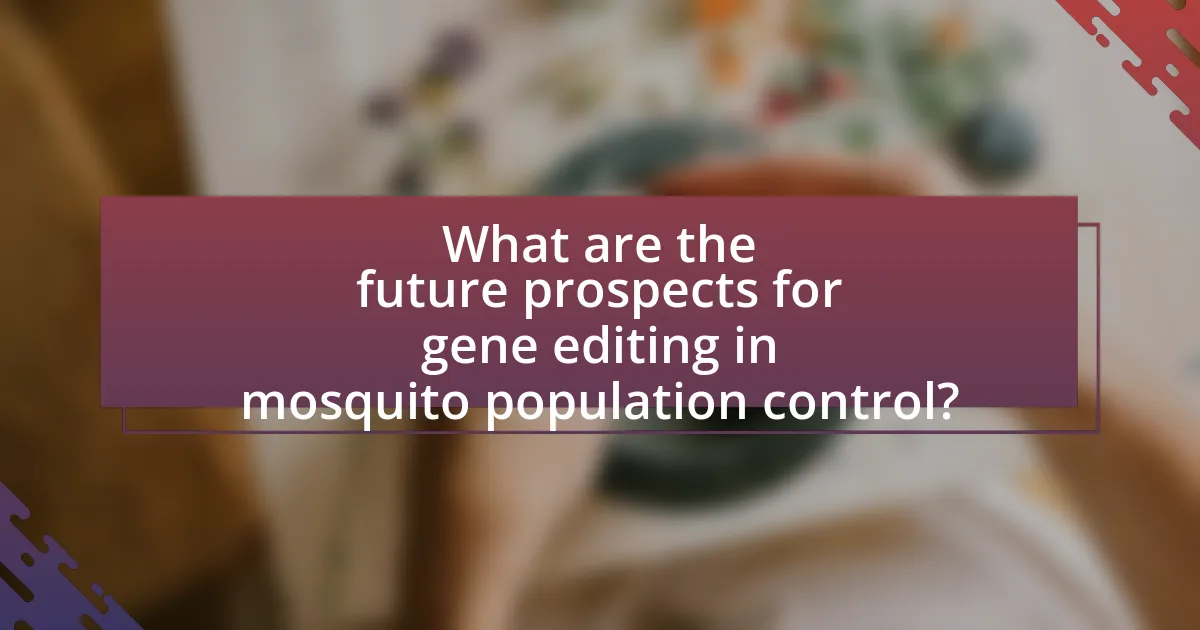
What are the future prospects for gene editing in mosquito population control?
The future prospects for gene editing in mosquito population control are promising, particularly with the development of technologies like CRISPR-Cas9, which allows for precise modifications in mosquito genomes. These advancements enable the creation of genetically modified mosquitoes that can reduce populations of disease-carrying species, such as Aedes aegypti, responsible for transmitting dengue and Zika viruses. For instance, a study published in Nature Biotechnology demonstrated that gene drive systems could spread genetic modifications rapidly through wild populations, potentially leading to significant declines in mosquito numbers. Additionally, regulatory frameworks are evolving to facilitate the safe release of genetically modified organisms, which supports the implementation of these technologies in real-world settings.
How can gene editing technologies evolve to improve effectiveness?
Gene editing technologies can evolve to improve effectiveness by enhancing precision, increasing delivery efficiency, and expanding target range. Advances in CRISPR-Cas9 systems, for instance, have led to the development of high-fidelity variants that minimize off-target effects, thereby increasing the accuracy of gene modifications. Additionally, innovations in nanoparticle-based delivery systems have shown promise in facilitating the efficient transfer of gene editing components into target cells, which is crucial for effective mosquito population control. Research published in “Nature Biotechnology” by Liu et al. (2020) demonstrates that improved delivery methods can significantly enhance the uptake of gene editing tools in mosquito embryos, leading to higher rates of successful modifications. Furthermore, expanding the range of target genes through multiplexed editing allows for the simultaneous alteration of multiple traits, which can be strategically used to disrupt mosquito reproduction or disease transmission pathways.
What innovations are on the horizon for mosquito gene editing?
Innovations on the horizon for mosquito gene editing include the development of advanced CRISPR techniques and gene drive systems aimed at controlling mosquito populations and reducing disease transmission. Researchers are exploring the use of CRISPR-Cas9 to create genetically modified mosquitoes that are resistant to pathogens like malaria and dengue fever. Additionally, gene drive technology is being refined to ensure that modified genes spread rapidly through wild populations, potentially leading to population suppression or extinction of disease-carrying species. These innovations are supported by studies demonstrating the effectiveness of gene drives in laboratory settings, indicating a promising future for mosquito gene editing in public health initiatives.
How might gene editing integrate with other pest control methods?
Gene editing can integrate with other pest control methods by enhancing the effectiveness and specificity of those methods. For instance, gene editing techniques like CRISPR can be used to create genetically modified mosquitoes that are resistant to diseases or have reduced reproductive capabilities, which can complement traditional methods such as insecticides and habitat management. Research has shown that combining gene editing with sterile insect technique (SIT) can lead to a more significant reduction in mosquito populations, as genetically modified males can outcompete wild males for mating, thereby decreasing the overall population. This integration not only improves pest control efficiency but also reduces reliance on chemical pesticides, aligning with sustainable agricultural practices.
What best practices should be followed in gene editing for mosquito control?
Best practices in gene editing for mosquito control include thorough risk assessment, stakeholder engagement, and adherence to regulatory frameworks. Conducting a comprehensive risk assessment ensures that potential ecological impacts and unintended consequences are identified and mitigated. Engaging stakeholders, including local communities and public health officials, fosters transparency and builds trust, which is crucial for the acceptance of gene editing technologies. Adhering to established regulatory frameworks, such as those set by the Environmental Protection Agency and the World Health Organization, ensures that gene editing practices meet safety and ethical standards. These practices are supported by studies indicating that responsible gene editing can effectively reduce mosquito populations while minimizing risks to non-target species and ecosystems.
How can researchers ensure the safety and efficacy of gene-edited mosquitoes?
Researchers can ensure the safety and efficacy of gene-edited mosquitoes by conducting rigorous risk assessments, implementing controlled field trials, and monitoring ecological impacts. Risk assessments evaluate potential unintended consequences on non-target species and ecosystems, while controlled field trials allow researchers to observe the behavior and interactions of gene-edited mosquitoes in natural settings. For instance, studies like those conducted by the Target Malaria project have demonstrated the importance of these methods in assessing the ecological effects of gene-edited organisms. Continuous monitoring post-release is essential to gather data on population dynamics and any unforeseen effects, ensuring that gene-edited mosquitoes fulfill their intended purpose without causing harm.
What lessons can be learned from past gene editing projects in other species?
Past gene editing projects in other species highlight the importance of ecological balance and unintended consequences. For instance, the gene drive technology applied to mice aimed to reduce populations but raised concerns about potential ecological disruption and the survival of non-target species. Additionally, the use of CRISPR in modifying crops demonstrated that while increased resistance to pests can be achieved, it may also lead to the emergence of resistant pest populations, necessitating ongoing management strategies. These examples underscore the need for thorough ecological assessments and long-term monitoring when implementing gene editing technologies in new contexts, particularly in sensitive ecosystems like those affected by mosquito populations.
